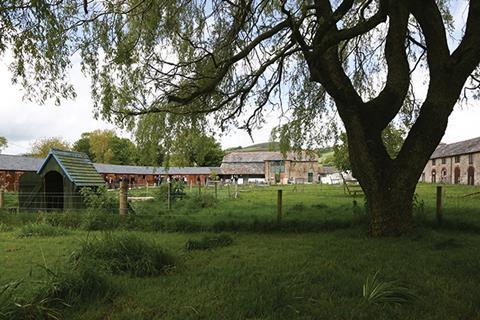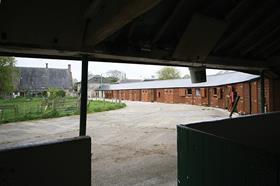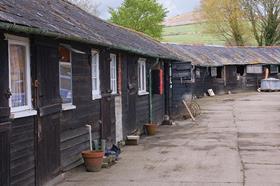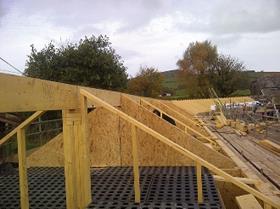When the refurbishment of a refuge for people in crisis ran into trouble, it left the community disillusioned with the building industry. But construction charity CRASH responded to its plea for help

On 5 April this year, the day of the Grand National, 30 or so people crowded round a flatscreen TV to watch the race - not in a pub or someoneÔÇÖs front room but in a former animal enclosure. Tucked away in a quiet valley deep in the Dorset countryside, the Pilsdon Community was watching the race as part of its celebration of handing over of an unusual building, one that had undergone a radical refurbishment since its days sheltering farm animals.
The building is part of phase two of a refurbishment programme, and has, in the six months since completion, transformed the quality of life of the residents at Pilsdon - a community that provides a sanctuary for people to recover from crises such as divorce, bereavement or addiction. Phase two of the work involved demolishing most of a 70m long stable block, building an entire new timber frame while complying with the rules for a listed building and fitting out the interior - all on a tiny budget.
But the fact is this building project very nearly failed before it even began. Before the industry charity CRASH brought on board a team led by EC Harris and Bam, the Pilsdon Community had gone through a traumatic experience on phase one of the project with a local contractor that subsequently went into voluntary liquidation. It was a sorry but familiar tale of a project that left the client with an unsatisfactory building, out of pocket and hugely disillusioned with the industry.
For several years CRASH has been ║├╔½¤╚╔·TVÔÇÖs charity partner and over that time we have reported on many of its efforts to help homeless people by harnessing the skills of the construction industry. So we decided to visit what is perhaps CRASHÔÇÖs most complex project to date to find out how the construction team pulled together to make it happen.
A unique community

When you visit Pilsdon today the setting seems so idyllic itÔÇÖs hard to imagine how stressful it must have been during the first phase of the building work. The original buildings, a mix of Victorian outhouses and stable blocks, as well as a main grade-II listed farm house built in the 1700s, are laid out to form an enclosed grassed farmyard area with a large willow tree, a duck pond and grazing cows.
The farm became a community back in 1958 to create a way of life centred on prayer, hospitality and work. Today there is still a Christian ethos but people of any faith and none are welcome, while the work is focused on maintaining an 11-acre small holding with dairy cows, beef cattle, sheep, pigs, chickens, ducks, and vegetable and fruit gardens. The idea is not for the community to be self-sufficient but to bind it together in a common purpose, providing meaningful work for some of the most vulnerable people in society.
Some of our suppliers even did it for nothing. Most suppliers did that because we invited them to Pilsdon and appealed to their better nature
Nick Goff, Bam Construction
But the communityÔÇÖs greatest physical asset - its buildings - were also its greatest financial burden: the old buildings did not meet acceptable modern standards for either people or animals. In many cases residents were having to share bedrooms, and bathrooms were located at the other end of long corridors. In particular, the east wing and the ÔÇ£loose boxesÔÇØ - a block of former stables, half of which were used as accommodation for occassional visitors and the other half to winter farm animals - needed essential roof repairs.
Starting on the back foot
The community estimated it would need about £1.3m (including a £50,000 grant from CRASH) to carry out the entire works on both the east wing (phase one), and the loose boxes (phase two). It engaged a contractor, Snibor Limited based in Gillingham, to take off the roof of the east wing and gut the entire building so that only the original stone walls remained standing. The plan was to rebuild the east wing and create bedrooms with ensuite bathrooms, a sports/recreation room, a TV lounge and one self-contained flat for when families wished to stay. In order to save money the community volunteered to do some of the work itself, including the internal decoration, installing the wooden flooring and the tiling.
But things did not go according to plan. ÔÇ£It was a nightmare,ÔÇØ says Dilys Hunt of the Pilsdon Community Trust. Perhaps most worrying of all was that the community didnÔÇÖt feel respected as a client by the contractor they had appointed. They didnÔÇÖt feel they were consulted about important and irreversible decisions that were being made on site, and they feared the needs of homeless people were not being recognised. At one point Hunt says she heard comments on site that reflected a complete lack of respect for homeless people in general.
Help is at hand
The lowest point came when Snibor finished on site around May 2011 and it was clear that the community was not happy with the finish on the east wing, but doubted it had enough of its original budget left undertake any of the refurbishment work on the loose boxes opposite. It was not just a case of being financially stretched, they felt emotionally drained by the project and had lost all trust in builders.
In January 2013 the contractor Snibor went into voluntary liquidation.



On the verge of giving up on the rest of the project, the community got in touch with CRASH for some advice. Francesca Roberts, CRASH chief executive, says: ÔÇ£It was difficult for CRASH to do much as we had not been involved [on site] from the start. We found volunteers to help them with finishing some of the work.ÔÇØ
This is when EC Harris and Bam got their first taste of working at Pilsdon. Their volunteering on the east wing led to a much bigger commitment on phase two of the project to renovate the loose boxes. Nick Goff, regional director at Bam Construction, explains what motivated him to get involved: ÔÇ£It was just not a good thing for a charity to experience, it deserved what the industry can do best. ThatÔÇÖs what triggered it for me.ÔÇØ
But for phase two to happen, CRASH had to secure the full support of its patrons for the most complex project it had ever undertaken: It was a real leap of faith  [We] had never supported a homelessness project to the all-encompassing degree I knew we would need to at Pilsdon, but I have always believed CRASH was capable of responding at that level if enough people and companies were prepared to make a serious commitment, says Roberts.
Tricky task
Once a team was assembled, getting on site proved tricky - nesting birds delayed matters by six months so the start date was pushed back from May to September 2013. Then it was a race to do most of the construction work by November when the farm animals would need shelter. This involved demolishing the old loose boxes, removing and reinstating the floor slab, installing drainage, constructing a timber frame and making the whole thing watertight with a new roof.
The key to getting the project done on such a tight timeframe and budget was partnering. BamÔÇÖs Goff says the contract was important in this respect: ÔÇ£We wanted to give Pilsdon an exemplary contract. It was a traditional design and build JCT contract but with a provision that when we priced the work, we would be looking to do it at a discount. We kept a clause that said if we could find further savings in our own work or through our supply chain we could pass it on.ÔÇØ
CRASH had a supply chain to support the companies but Bam tapped into its own supply chain too, and BamÔÇÖs Goff thinks a total of between 20 and 30 suppliers helped the project. He says: ÔÇ£Some of our suppliers even did it for nothing. Most suppliers did that because we invited them to Pilsdon and appealed to their better nature.ÔÇØ
To make the build quicker and cheaper the team opted for a timber frame - the problem was the buildingÔÇÖs rear stone wall had to be retained as part of the listing requirements. In addition, the old building was curved in plan and dropped in level by about a foot from one end to the other. The solution was to bring in Stewart Milne Timber Systems to fabricate the timber panels off site.
Designing the internal layout was not straightforward either. Austin Fews at NVB Architects, a practice in Frome, Somerset, says: ÔÇ£We had several meetings really drilling down, trying to tease out what exactly was needed and how best use the space.ÔÇØ The original idea had been to provide eight bedrooms for ÔÇ£wayfarersÔÇØ, homeless people who only want a bed for a night or two, and some space for cattle. However, the architect suggested that as the bedrooms would not be permanently occupied they could be halved in number and made smaller. To the surprise of the client this created space for a meeting room and a food preparation room.

The bulk of the structural work was finished by Christmas, at which point the community thought it would have to stop, having run out of funds after achieving the bare minimum of a waterproof shell. However, acombination of enthusiastic fundraising by Pilsdon, some clever design work, and subcontractors providing materials and services for nothing, meant Bam was able to finish the fit-out of the building. The design for the bedroom interiors allowed all the furniture to be kept off the floor and attached to the walls to make it quick and easy to clean (see drawing above). The bed, side table, wash basin and wardrobe units are all made from a composite board. ÔÇ£Doing something cheaply normally doesnÔÇÖt end well. But this was a nice feeling because by being efficient they had exactly what they wanted.ÔÇØ says BamÔÇÖs Goff.
Finishing touches
Twenty six weeks after starting on site the project was complete. In that time CRASH and its patrons provided over £169,000 in professional expertise, free of charge materials and discounted materials. In addition to that it gave a total cash grant of £30,250, of which £15,250 came from
We wonÔÇÖt find another project like that with meetings in a library or a church, in the middle of nowhere. It was a great place to go because people were so happy to have you there. It was a completely different atmosphere, a great experience
Scott Moore, EC Harris
EC Harris, which also provided about £20,000 of pro-bono work. The total estimated cost of the build without any input from CRASH had been put at over £461,000, so the ultra collaborative approach delivered extraordinary value.
In the end the quality of the building the team was able to hand over to the client exceeded the communityÔÇÖs expectations, and by the same token it felt good for the project team to have an appreciative client. EC HarrisÔÇÖ Scott Moore, who was the project QS and project manager, says: ÔÇ£We wonÔÇÖt find another project like that with meetings in a library or a church, in the middle of nowhere. It was a great place to go because people were so happy to have you there. It was a completely different atmosphere, a great experience.ÔÇØ
BamÔÇÖs Goff adds: ÔÇ£Most of my guys say itÔÇÖs the best job they have ever worked on, and thatÔÇÖs because of the people. We were almost sad it was over - glad to finish on time but sorry not to be still working with them.ÔÇØ
And for the community, the industry has clearly redeemed itself, to such an extent that they are now really looking forward to being a construction client again - thereÔÇÖs still plenty of building work to do at Pilsdon. Hunt is clearly impressed by the professionalism of the team but also by their commitment to go above and beyond for the community: ÔÇ£On the day of the official handing over in May, I just couldnÔÇÖt believe it. All the hanging baskets and planters were filled with plants and there were even welcome mats in each of the rooms. It was unbelievable.ÔÇØ
Bam even donated the flatscreen TV, which had its first screening for that fondly remembered Grand National - but by that time, the community probably felt theyÔÇÖd already won it.



























No comments yet